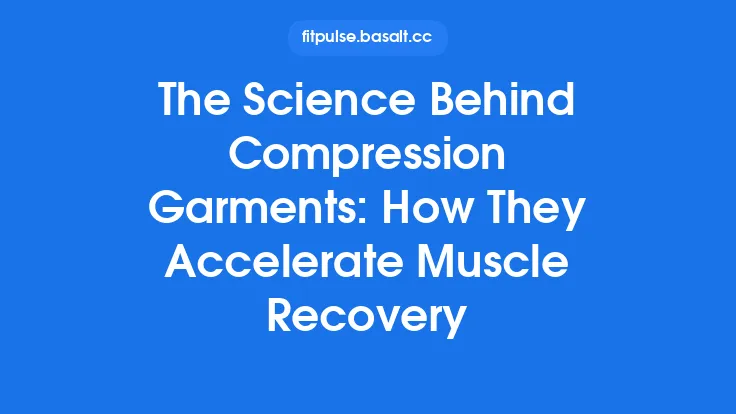The period after a training session is a dynamic phase in which the body works to restore the molecular and cellular substrates that were depleted, repair structural damage, and prepare for the next bout of activity. While the workout itself is the obvious stimulus, the recovery window determines how quickly and efficiently those adaptations become permanent. Understanding the physiological processes that govern the replenishment of energy stores, the synthesis of new proteins, and the re‑establishment of fluid and electrolyte balance equips athletes, coaches, and health‑professionals with the tools to design evidence‑based recovery protocols that enhance performance and reduce injury risk.
Phosphocreatine Resynthesis: The Immediate Energy Buffer
The phosphocreatine (PCr) system provides rapid ATP regeneration during the first few seconds of high‑intensity effort. During a sprint or a heavy lift, ATP is hydrolyzed to ADP, and the creatine kinase reaction transfers a high‑energy phosphate from PCr to ADP, restoring ATP almost instantaneously. This reaction is reversible; once the bout ends, the body must rebuild the PCr pool.
- Rate‑Limiting Factors – PCr resynthesis is primarily limited by mitochondrial oxidative capacity and the availability of ADP and inorganic phosphate. In well‑trained individuals, the half‑time for PCr restoration is typically 30–45 seconds, whereas in untrained subjects it can exceed 60 seconds.
- Oxygen Dependence – Although the PCr system itself is anaerobic, its replenishment relies on oxidative phosphorylation. The rapid increase in oxygen consumption post‑exercise (the “EPOC” – excess post‑exercise oxygen consumption) reflects the metabolic cost of restoring PCr, re‑phosphorylating ATP, and clearing metabolic by‑products.
- Practical Implications – Short rest intervals (≤30 seconds) between repeated high‑intensity efforts allow only partial PCr recovery, which can be strategically used to train the capacity to tolerate low PCr levels. Conversely, longer rest periods (≥3 minutes) enable near‑complete PCr restoration, supporting maximal power output in subsequent sets.
Glycogen Repletion: Carbohydrate Strategies
Muscle glycogen is the principal storage form of carbohydrate and the dominant fuel for moderate‑to‑high‑intensity exercise lasting beyond a few minutes. Depletion of glycogen during training is a primary driver of fatigue, and its restoration is a cornerstone of recovery.
- Time Course of Repletion – In the immediate 2‑hour window after exercise, muscle glycogen can be restored by ~30–40 % of the depleted amount if carbohydrate intake is sufficient. Full restoration (≈100 % of pre‑exercise levels) typically requires 24 hours, though this can be accelerated to 12 hours with optimal nutrition.
- Carbohydrate Quantity – Research consistently shows that ingesting 1.0–1.2 g of carbohydrate per kilogram of body mass per hour during the first 4 hours post‑exercise maximizes the rate of glycogen synthesis. Doses above ~1.5 g·kg⁻¹·h⁻¹ provide diminishing returns unless the exercise was exceptionally glycogen‑depleting (e.g., ultra‑endurance events).
- Carbohydrate Type and Glycemic Index – High‑glycemic carbohydrates (e.g., glucose, maltodextrin) raise blood glucose rapidly, stimulating insulin secretion and enhancing glycogen synthase activity. However, a mixed approach that includes some low‑glycemic sources can improve gastrointestinal comfort and sustain glucose availability over longer periods.
- Co‑Ingestion with Protein – Adding 0.2–0.3 g·kg⁻¹ of high‑quality protein to carbohydrate meals further augments glycogen storage by increasing insulin release and providing amino acids that support glycogen‑synthesizing enzymes.
Protein Synthesis and Muscle Repair
Resistance‑type exercise, eccentric loading, and high‑intensity interval work all generate micro‑trauma to myofibrils and the extracellular matrix. The repair process is mediated by muscle protein synthesis (MPS), which must outpace protein breakdown (MPB) for net accretion.
- MPS Kinetics Post‑Exercise – MPS rises sharply within 1–2 hours after resistance training, peaks around 3–5 hours, and remains elevated for up to 24 hours, depending on the volume and intensity of the stimulus. This window is often referred to as the “anabolic window,” though recent data suggest that the period of heightened sensitivity can be broader.
- Optimal Protein Dose – Approximately 0.25–0.30 g·kg⁻¹ of high‑quality protein (containing ≥2.5 g of essential leucine) per feeding maximally stimulates MPS in most adults. For larger individuals or those engaged in very high‑volume training, doses up to 0.4 g·kg⁻¹ may be warranted.
- Leucine and mTOR Activation – Leucine acts as a key signaling molecule for the mechanistic target of rapamycin (mTOR) pathway, which governs translation initiation. Consuming protein sources rich in leucine (e.g., whey, soy, dairy) shortly after training accelerates the MPS response.
- Timing and Distribution – Spreading protein intake evenly across 3–4 meals throughout the day (≈0.3 g·kg⁻¹ per meal) sustains a favorable net protein balance, especially during periods of repeated training sessions.
Rehydration and Electrolyte Restoration
Sweat loss during exercise removes not only water but also electrolytes—primarily sodium, potassium, chloride, magnesium, and calcium. Adequate rehydration restores plasma volume, supports cellular function, and influences subsequent performance.
- Quantifying Fluid Loss – Weighing an athlete before and after a session (with clothing accounted for) provides an estimate of fluid loss; each kilogram of body mass lost corresponds to roughly 1 L of fluid.
- Sodium’s Central Role – Sodium drives thirst and promotes water retention via the renal system. Post‑exercise drinks containing 30–50 mmol·L⁻¹ (≈700–1200 mg·L⁻¹) of sodium are effective at stimulating fluid intake and minimizing urine output.
- Potassium and Muscle Function – While potassium losses are smaller, they are critical for maintaining membrane excitability. Including potassium‑rich foods (e.g., bananas, potatoes) in the recovery meal helps re‑establish intracellular balance.
- Practical Rehydration Protocol – Consuming 1.5 L of fluid for each kilogram of body mass lost, split over the first 2–4 hours post‑exercise, with added electrolytes, restores plasma volume and supports metabolic processes involved in energy‑store replenishment.
Hormonal Environment of Recovery
Exercise elicits a cascade of hormonal responses that influence substrate utilization, protein turnover, and tissue repair. The post‑exercise hormonal milieu can be harnessed to accelerate recovery.
- Insulin – Elevated by carbohydrate and protein ingestion, insulin promotes glucose uptake, glycogen synthesis, and amino acid transport into muscle cells. Its anti‑catabolic effect also suppresses MPB.
- Growth Hormone (GH) and IGF‑1 – Both rise during and after intense exercise, stimulating protein synthesis and satellite‑cell activation. Adequate sleep and adequate protein intake amplify these effects.
- Cortisol – A catabolic hormone that peaks shortly after strenuous activity. While necessary for mobilizing energy substrates, prolonged elevation can impair MPS. Strategies such as carbohydrate intake and stress management help attenuate excessive cortisol.
- Testosterone – Acute resistance training raises circulating testosterone, supporting anabolic processes. Adequate recovery sleep, balanced nutrition, and avoidance of chronic overtraining preserve optimal testosterone levels.
The Role of Sleep and Circadian Rhythms
Sleep is arguably the most potent, yet often underappreciated, recovery tool. It orchestrates hormonal secretion, tissue repair, and neural restoration.
- Sleep Architecture and Recovery – Deep slow‑wave sleep (stage 3) is associated with peak GH secretion, while REM sleep supports neural plasticity and cognitive recovery. Both stages are essential after demanding training sessions.
- Quantity and Quality – Most adults require 7–9 hours of sleep per night for optimal performance. Athletes engaging in heavy training may benefit from 9–10 hours, including short naps (20–30 minutes) to mitigate fatigue.
- Circadian Timing of Nutrition – Aligning nutrient intake with the body’s internal clock (e.g., consuming a carbohydrate‑protein blend within the first 2 hours of waking) can enhance glycogen storage and MPS due to diurnal variations in insulin sensitivity.
Active Recovery and Blood Flow
Low‑intensity activity performed shortly after a hard session—often termed “active recovery”—facilitates metabolic clearance and promotes nutrient delivery.
- Enhanced Lactate Clearance – Although lactate is not a primary focus of this article, its removal is accelerated by increased muscle perfusion, which also aids in transporting glucose and amino acids to fatigued fibers.
- Shear Stress and Endothelial Function – Light aerobic work (e.g., cycling at 30–40 % VO₂max for 10–15 minutes) generates shear stress on vascular walls, stimulating nitric oxide production and improving subsequent vasodilation.
- Practical Implementation – Incorporating a 5–10 minute cool‑down at a comfortable pace, followed by a brief session of gentle mobility work, can reduce perceived soreness and improve the rate of substrate replenishment.
Nutrient Timing and the Anabolic Window
While the concept of a narrow “anabolic window” has been refined, timing still matters for maximizing recovery efficiency.
- Early Post‑Exercise Window (0–2 h) – This period is characterized by heightened insulin sensitivity and elevated MPS signaling. Consuming a mixed carbohydrate‑protein beverage (≈1 g·kg⁻¹ carbohydrate + 0.25 g·kg⁻¹ protein) optimally exploits this state.
- Mid‑Recovery Phase (2–6 h) – Continued provision of moderate‑glycemic carbohydrates sustains glycogen synthesis, while additional protein doses maintain a positive net protein balance.
- Late Recovery (6–24 h) – Whole‑food meals rich in complex carbohydrates, lean proteins, and healthy fats support ongoing repair processes and replenish micronutrient stores (e.g., magnesium, zinc) essential for enzymatic activity.
Supplemental Interventions
Targeted supplementation can complement dietary strategies, especially when training demands exceed normal recovery capacity.
| Supplement | Primary Action | Typical Dose | Evidence Summary |
|---|---|---|---|
| Creatine Monohydrate | Replenishes intramuscular creatine, accelerates PCr resynthesis | 3–5 g daily (maintenance) | Robust data show faster PCr recovery and improved repeated‑sprint performance |
| Beta‑Alanine | Increases muscle carnosine, buffers H⁺ during high‑intensity work | 3–6 g/day (split) | Helps reduce fatigue in sessions that heavily tax the phosphagen system |
| Omega‑3 Fatty Acids | Anti‑inflammatory, may enhance MPS | 1–2 g EPA/DHA | Moderate evidence for reduced DOMS and improved muscle protein turnover |
| Vitamin D | Supports immune function and muscle health | 1000–2000 IU/day (if deficient) | Deficiency linked to impaired recovery; supplementation restores normal function |
| Electrolyte Powders | Replaces sodium, potassium, magnesium lost in sweat | 300–600 mg sodium per L of fluid | Proven to improve fluid retention and reduce cramping during rehydration |
Supplementation should be individualized, considering dietary intake, training load, and any medical conditions.
Practical Guidelines for Optimizing Post‑Exercise Recovery
- Immediate Fluid Replacement – Begin rehydration within 15 minutes of finishing the session; aim for 150–250 mL of a sodium‑containing beverage per kilogram of body mass lost.
- Carbohydrate‑Protein Mix – Within the first 30–60 minutes, ingest 1.0–1.2 g·kg⁻¹ carbohydrate plus 0.25–0.3 g·kg⁻¹ high‑quality protein.
- Structured Protein Distribution – Continue to provide ~0.3 g·kg⁻¹ protein every 3–4 hours for the next 24 hours.
- Sleep Prioritization – Ensure 8–10 hours of sleep, with a consistent bedtime, and consider a short nap if training volume is high.
- Active Cool‑Down – Perform 5–10 minutes of low‑intensity activity followed by mobility work to promote circulation.
- Electrolyte Balance – Include sodium (≈700 mg/L) in post‑exercise fluids; add potassium‑rich foods to meals.
- Monitor Recovery – Use simple tools (e.g., daily wellness questionnaires, HRV tracking) to gauge readiness and adjust nutrition or rest accordingly.
- Periodize Recovery – Align higher‑intensity blocks with increased carbohydrate and protein intake, and schedule lighter weeks to allow full glycogen and tissue restoration.
By integrating these evidence‑based strategies, athletes can accelerate the replenishment of phosphocreatine, glycogen, and protein stores, maintain optimal fluid‑electrolyte balance, and create a hormonal environment conducive to adaptation. The cumulative effect is not only improved performance in subsequent sessions but also a reduced risk of overtraining and injury, ensuring long‑term progression in any training program.





